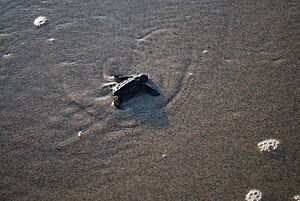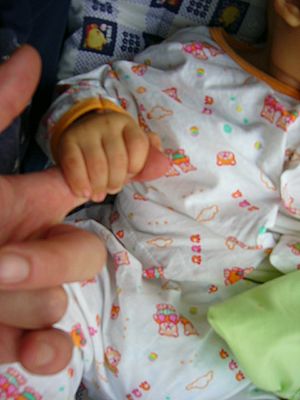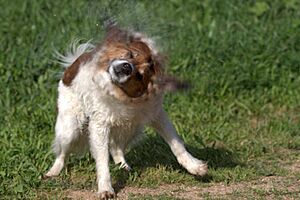Instinct facts for kids
An instinct is a natural, inborn way that living things behave. It's like a built-in program that tells an animal or even a human how to act in certain situations, without needing to learn it first. For example, a baby sea turtle hatching on a beach will immediately know to crawl towards the ocean. It doesn't need anyone to teach it.
Instinctive behaviors are complex actions that happen automatically. They are different from simple reflexes, which are quick, automatic body responses to something specific, like your eye blinking when a bright light shines. Instincts are more involved, like a bird building a nest or a dog shaking water off its fur.

Contents
Studying Instincts
Scientists have been curious about instincts for a long time. They wanted to understand why animals and humans act the way they do without being taught.
Jean Henri Fabre: Insect Expert
Jean Henri Fabre (1823–1915) was a French scientist who loved studying insects. He was one of the first to really focus on how insects behave. Fabre believed instincts were like "fixed patterns" – a set of actions an animal does automatically when certain things happen around it.
He noticed that insects often repeated the same actions, even if those actions didn't help them in a new situation. For example, he studied wasps that always followed a specific routine to catch their prey. Even when Fabre changed things around, most wasps still stuck to their usual pattern. This showed him that their behaviors were deeply ingrained.
Some of the "instinctive" behaviors Fabre observed in insects and animals include:
- Mothers caring for their young (maternal instincts).
- Metamorphosis, like a caterpillar changing into a butterfly.
- Mimicry, where one animal looks like another to protect itself.
- Molting, when animals shed their skin or feathers.
- Playing dead to avoid predators.
- Taxis, which is when an animal moves towards or away from a stimulus, like light.
Wilhelm Wundt: Early Psychology
Wilhelm Wundt (1832–1920) is famous for starting the very first psychology laboratory. He watched both animals and humans closely to understand instincts.
Wundt thought that many of our automatic actions, like certain facial expressions, came from our feelings and sensations. He believed these unconscious actions were steps towards how we become aware and think. For instance, he observed how babies made specific faces when tasting sweet, sour, or bitter things. He thought these were instincts that helped past generations survive.
Sigmund Freud: Inner Drives
Sigmund Freud believed that our inner needs, like hunger or thirst, create mental "desires" or instincts. He called these "biological forces that motivate individuals to satisfy their needs."
Freud talked about two main types of instincts:
- Life instincts (Eros): These are about survival, growing, and feeling good.
- Death instincts (Thanatos): These are linked to aggression and sometimes self-destruction.
He thought these instincts were very important in shaping who we are and how we act.
William McDougall: Instincts and Emotions
William McDougall in the early 1900s connected instincts with specific emotions. He suggested that many instincts come with their own feelings. Later, he thought the word "instinct" was better for animals. For humans, he preferred "propensity" because human actions are more flexible and can be changed by experience.
Abraham Maslow: Human Choice
In the 1950s, psychologist Abraham Maslow suggested that humans might not have true instincts anymore. He argued that because we can choose to ignore or change our natural urges, they are more like strong "drives" than unchangeable instincts. He believed a true instinct couldn't be overridden.
Konrad Lorenz: Learning and Instinct
Konrad Lorenz (1903–1989) was a scientist who studied animal behavior. He helped us understand the difference between what animals are born knowing and what they learn.
He famously showed how baby geese would follow the first moving thing they saw after hatching, thinking it was their mother. This is called imprinting. Lorenz had a goose imprint on his boots! This showed that while the goose's behavior to follow its "mother" was instinctive, who it considered its mother was something it learned during a special "sensitive period."
Instincts in Humans
While many instincts are clearer in animals, humans also show behaviors that seem to be influenced by instinct.
- Fear of dangers: Babies as young as six months old can show a natural readiness to be afraid of things like snakes and spiders.
- Baby's cry: An infant's cry is an instinctive way for a baby to get attention and protection, especially since they can't take care of themselves. Parents often feel a strong urge to respond to their baby's cries.
- Social connection: Humans, especially children, often show a "herd instinct" or a desire to be part of a group.
- Hormone influence: Our hormones can affect our behavior. For example, higher levels of testosterone can sometimes be linked to more aggressive behavior.
- Hygiene: Some scientists think our desire for cleanliness, linked to feelings like disgust, might have an instinctive part.
- Maternal care: The strong bond a mother feels for her child, often called maternal instinct, helps her care for her baby's well-being. A hormone called oxytocin is thought to play a role in this bonding.
- Self-preservation: People generally have a strong instinct to survive and protect themselves.
- Fight-or-flight: When faced with danger, humans often have an automatic "Fight-or-flight" response, preparing them to either confront the threat or run away.
- Cooperation: Working together with others, or social instinct, is seen as important for human survival.
- Adapting to the environment: Many behaviors that help us survive and thrive, like finding food, mating, or being aware of our surroundings, have an instinctive basis.
Reflexes
Reflexes are very simple, automatic responses. They often don't even need your brain to think about them! Instead, the message travels to your spinal cord and back, causing a quick reaction. Think of your knee jerking when a doctor taps it.
While reflexes are simple, some instincts can also be very automatic. For example, a male stickleback fish will instinctively attack anything red during mating season. This is a complex action, but it's still automatic. In mammals, like rats, special organs in their nose can detect chemicals that trigger innate responses, like fear of a predator.
Growing and Instincts
Some instincts don't appear right at birth but develop as an animal grows. This is called maturation. For example, baby birds don't fly immediately. But if you keep them from moving their wings until they are old enough to fly, they will fly perfectly fine the moment they are released. This shows that their ability to fly comes from their bodies maturing, not from learning how to flap their wings.
Instincts and Evolution
Instincts are very important for survival and have developed over long periods through natural selection. For example, the imprinting behavior in baby birds helps them stay close to their parents, which keeps them safe and helps them learn. This increases their chances of surviving and having their own offspring.
The environment also plays a big role in how instincts develop and are expressed. Our brains have special areas, like the limbic system, that help control many instinctual behaviors. These areas process things like emotions and social cues, leading to actions like caring for young, defending ourselves, or interacting in groups. Animals use their senses, like smell, to detect important signals that trigger these instincts, such as finding a mate or sensing danger.
Scientists study instincts from many different angles, from how genes work to how groups of animals behave. It's a fascinating field that helps us understand the amazing built-in abilities of living things.
See also
 In Spanish: Instinto para niños
In Spanish: Instinto para niños
- Drive theory
- Ethology
- Genetic memory
- Heuristic
- Human ethology
- Innatism
- Prey drive (hunting instinct)
- Psychological nativism
- Rationality
- Sociobiology
- Unconscious mind



